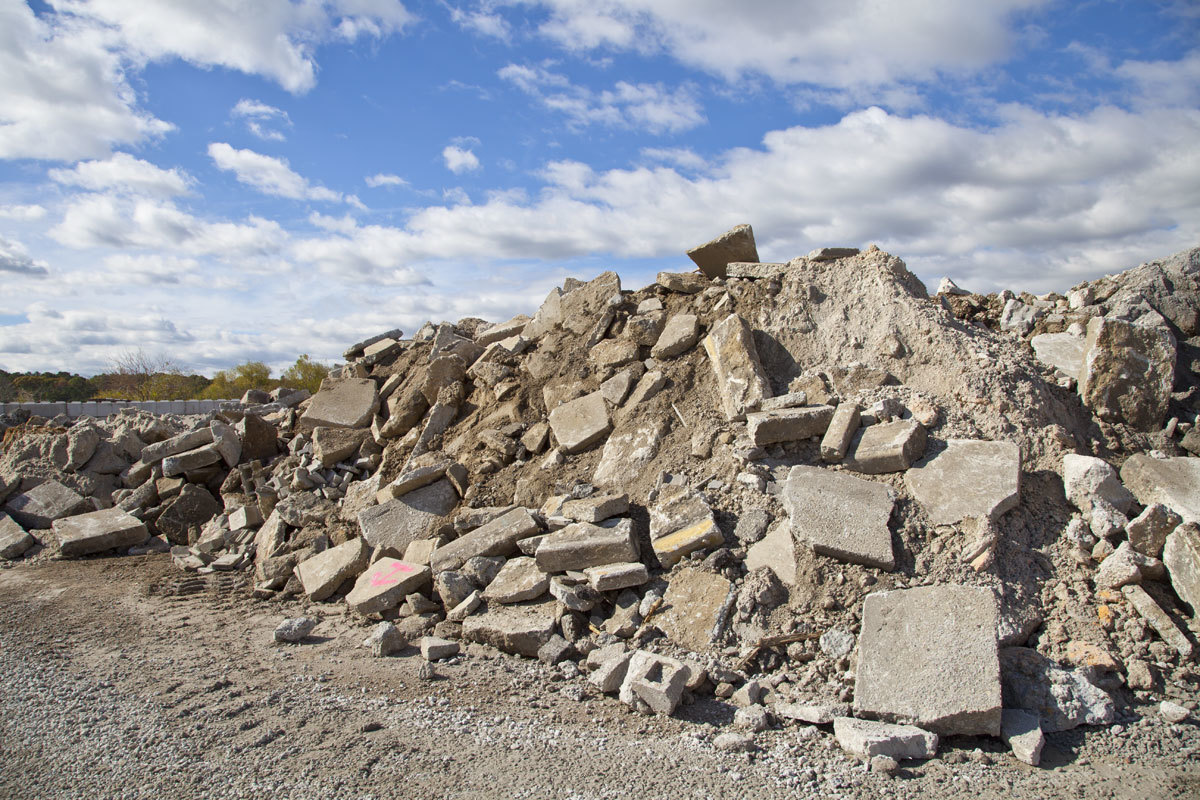Posted on April 15, 2021
It is a basic axiom of environmental stewardship. When possible, use old stuff to make new stuff. The same is true with concrete aggregates. Mixes are more sustainable when recycled concrete aggregate (RCA) replaces natural aggregates, at least to a degree.

Analyzing Performance of RCA
The use of RCA in large-scale concrete production is not yet widely accepted. Challenges include high porosity, inconsistencies in the material and a lack of field studies.
Recent research in western Canada addresses the latter. The study occurred at the Green Construction Research and Training Centre of the University of British Columbia. There, researchers recently completed a five-year study of recycled concrete. The study further confirmed the viability of RCA in structural applications. The Natural Sciences and Engineering Research Council of Canada (NSERC), OK Builders Supplies and KonKast Products provided funding.
The study looked at using recycled concrete in two very different settings. The first was building foundations, and the second was municipal sidewalks. In both instances, concrete using recycled aggregates was competitive with traditional concrete. Both durability and compressive strength were comparable. In some categories, the RCA concrete outperforms traditional concrete. Compressive strength at 28 days was actually higher than that of concrete using natural aggregates. They suggest that structural uses will expand with further innovation.
Researchers also tested the performance of RCA concrete at Chicago’s O’Hare International Airport. They placed a lane of concrete with virgin aggregates next to a lane of concrete using recycled aggregate. The contractor obtained the material from demolition right at the airport. Sensors in the concrete measured temperature, relative humidity and lift-off. Researchers also monitored surface appearance and joint width. Five months after placement, differences were statistically insignificant.
Recycled Concrete and Sustainability
RCA concrete addresses a series of environmental challenges. As a result, researchers look for ways to increase the use of recycled material in concrete mixes.
Concrete with recycled aggregates promotes sustainability in various ways.
Reduce the strain on landfill and save the associated costs.
Lessen the environmental impact of extracting and preparing virgin aggregate.
Getting material from urban demolition sites reduces overall transportation costs. There is less need to bring in virgin aggregates from distant quarries.
More carbonation occurs during crushing and processing.
The use of RCA may qualify projects for LEED credits. These credits are in the “materials and resources” and “construction waste management” categories.
Promoting Recycling
The Construction & Demolition Recycling Association (CDRA) promotes the recycling of C&D materials. More than 583 million tons of such material is generated each year in the United States. This includes concrete, asphalt, asphalt shingles, wood, metals and gypsum. Recycling already saves an estimated 4,300 acres of landfill per year.
Crushcrete is a recycling company based in Bethlehem, PA. It estimates that 140 million tons of concrete is recycled annually in the United States. Lafarge Holcim is a global building products producer doing business in more than 70 countries. Its Geocycle brand provides waste management services to thousands of companies. In 2019, Geocycle processed more than 10 million tons of waste. LaFarge Holcim's Susteno cement includes fine mixed granulates from demolished buildings.
The Recycling Process
Old concrete comes from diverse sources. Pavements, curbs, sidewalks, runways and building pillars and slabs are some examples. For many transportation projects, contractors process concrete onsite with a mobile crusher. Magnetic separators remove reinforcing steel. Screening removes dirt and other fine particles. The result is a mixture of high-quality mineral aggregates and hardened cement paste. Recycled aggregates for Portland cement concrete (PCC) are also sorted by size.
Recycling old concrete is not without its challenges. It is necessary to remove embedded material like reinforcing steel. Contamination is also an issue. Contaminants include dirt, clay, asphalt, gypsum board, plaster and wood. Chlorides, glass, sealants are other examples. Removal involves selective demolition, screening or air separation and size reduction via crusher.
For detailed RCA information, see the report “ACI PRC-555-01: Removal and Reuse of Hardened Concrete.”
Uses for Processed and Unprocessed RCA
At present, more than two-thirds of recycled concrete aggregate becomes road base. Nine percent goes into asphalt and another six percent into concrete mixes.
Contractors use unprocessed material is for:
Pavement sub-bases
Bank stabilization and protection
General bulk fills
Drainage base and/or fill
Noise barriers
Processed RCA is often used in these ways:
Structural grade concrete
Pavements, shoulders and median barriers
Sidewalks, curbs and gutters
Bridge foundations
Soil-cement pavement bases
Econocrete bases
Bituminous concrete
Researchers continue to look for ways to expand the use of recycled aggregates in structures.
RCA Challenges
RCA contains hydrated cement paste. This increases porosity well beyond that of virgin aggregates. The presence of hydrated cement also reduces its specific gravity. Still, in many non-structural applications, recycled aggregates are acceptable as a full replacement for quarried material.
In structural applications, one must account for RCA’s higher water absorption rate. Therefore, there are limits on the amount of recycled aggregate that can be used in a concrete mix. Higher amounts increase drying shrinkage and creep. Higher amounts also decrease tensile strength and modulus of elasticity.
Testing determines acceptable ratios of recycled aggregates to natural aggregates. In many applications, replacement rates of 10-20 percent are acceptable. Replacement rates of up to 30 percent are possible in some applications.
Finally, it is important to avoid indiscriminate mixing of source material. Aged concrete of very low quality may compromise concrete mixes. It is important that such material not undermine performance.
About PACA
The Pennsylvania Aggregates and Concrete Association (PACA) operates specifyconcrete.org. For further assistance, please contact us.
